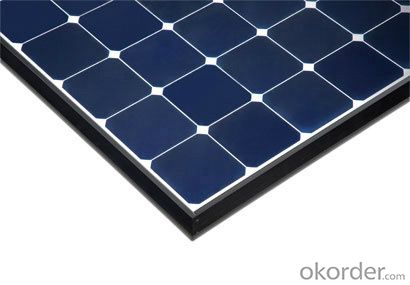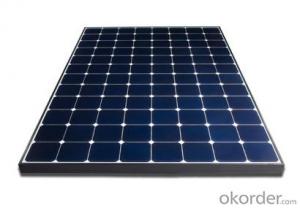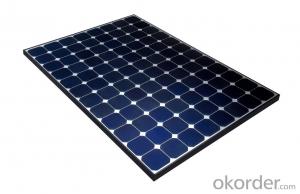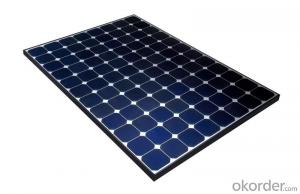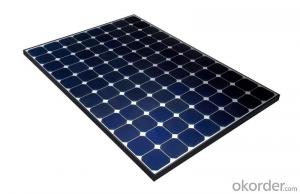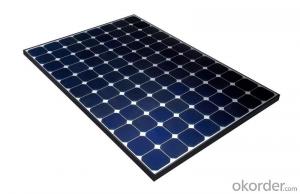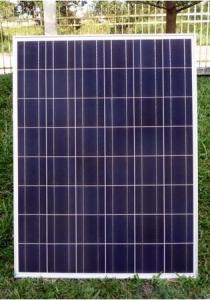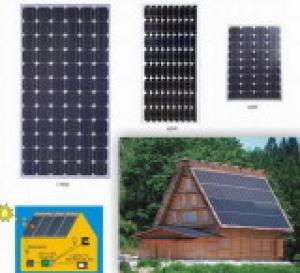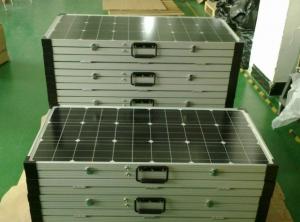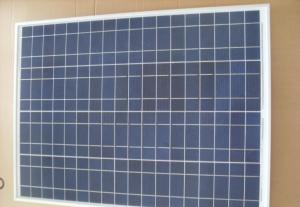CNBM Poly 400W Solar Panels with TUV UL CE Certificate for Residential
- Loading Port:
- Shanghai
- Payment Terms:
- TT OR LC
- Min Order Qty:
- 500 watt
- Supply Capability:
- 1000 watt/month
OKorder Service Pledge
OKorder Financial Service
You Might Also Like
Specification
CNBM Poly 230W Solar Panel with TUV UL CE Certificate For Residential
Introduction
Electrical connections are made in series to achieve a desired output voltage and/or in parallel to provide a desired current capability. The conducting wires that take the current off the modules may contain silver, copper or other non-magnetic conductive [transition metals]. The cells must be connected electrically to one another and to the rest of the system. Externally, popular terrestrial usage photovoltaic modules use MC3 (older) or MC4 connectors to facilitate easy weatherproof connections to the rest of the system.
Each module is rated by its DC output power under standard test conditions, and typically ranges from 100 to 365 watts. The efficiency of a module determines the area of a module given the same rated output – an 8% efficient 230 watt module will have twice the area of a 16% efficient 230 watt module. There are a few solar panels available that are exceeding 19% efficiency. A single solar module can produce only a limited amount of power; most installations contain multiple modules. A photovoltaic system typically includes a panel or an array of solar modules, a solar inverter, and sometimes a battery and/or solar tracker and interconnection wiring.
Micro-inverted solar panels are wired in parallel which produces more output than normal panels which are wired in series with the output of the series determined by the lowest performing panel (this is known as the "Christmas light effect"). Micro-inverters work independently so each panel contributes its maximum possible output given the available sunlight.[6
In contrast, a solar thermal collector supplies heat by absorbing sunlight, for the purpose of either direct heating or indirect electrical power generation from heat. A "photoelectrolytic cell" (photoelectrochemical cell), on the other hand, refers either to a type of photovoltaic cell (like that developed by Edmond Becquerel and modern dye-sensitized solar cells), or to a device that splits water directly into hydrogen and oxygen using only solar illumination.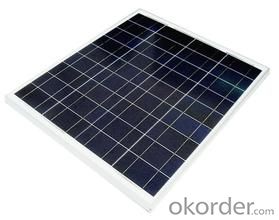
Suggested application
Home lighting business lighting,
Garden lighting, pavement lighting
Farmer household lighting
Decorative water pump
Traffic signal lighting
Industry area
Business area
Solar Power Plant
Product feature
Modules are made of Monocrystalline or Polycrystalline Silicon cell.
Materials and color of the solar panel frame: Clear anodized aluminum alloy type 6063T5 Universal frame; Silver-white color;
The output connection gathers the coupling: Selects conforms to the IEC-612615; 2005, class II, IEC61730 international standard; Airtight waterproofing binding clamp;
Module seal structure: The surface is thick, the high diaphanous rate armored glass with solar cell board special-purpose 3.2mm becomes after the high temperature lamination craft. The back selects has waterproof and anti- aged performance fine TPT materials. The entire block battery board has, the waterproofing, the anti- aging airtight and so on the fine performance;
Power tolerance: +/-3%
Packaging
International standard cartons (according to the requirements of customers)
- Q: Rooftop solar panel (not sure if rubber or plastic?) has leak arising from thin vertical crack in panel about long. Any ideas for repair?Thanks.
- bypass the whole panel if you can ( one individual panel of several ) , or bypass that loop in that panel - car part rubber hose clamps
- Q: Can solar panels be used for powering a marina or boating facility?
- Yes, solar panels can be used to power a marina or boating facility. Solar panels are a sustainable and efficient source of electricity that can provide clean energy to run various equipment, lighting, and charging stations at the marina or boating facility. Additionally, solar power can help reduce dependency on fossil fuels and lower operating costs in the long run.
- Q: what are solar panels?
- A solar panel is a device that collects and converts solar energy into electricity or heat which can be used by (for example) nearby buildings. Solar photovoltaic panels can be made so that the sun's energy excites the atoms in a silicon layer between two protector panels. Electrons from these excited atoms form an electric current, which can be used by external devices. Solar panels were in use over one hundred years ago for water heating in homes. Solar panels can also be made with a specially shaped mirror that concentrates light onto a tube of oil. The oil then heats up, and travels through a vat of water, instantly boiling it. The steam created turns a turbine for power. The basic element of solar panels is pure silicon. When stripped of impurities, silicon makes an ideal neutral platform for transmission of electrons. In silicon’s natural state, it carries four electrons, but has room for eight. Therefore silicon has room for four more electrons. If a silicon atom comes in contact with another silicon atom, each receives the other atom's four electrons. Eight electrons satisfy the atoms' needs, this creates a strong bond, but there is no positive or negative charge. Silicon atoms combine for years to produce a large piece of pure silicon. This material is used on the plates of solar panels. Combining silicon with other elements that have a positive or negative charge can also create solar panels.
- Q: So lets say that Everyday I use ,280 kWh. How many 250 watt solar panels would I buy so that I don't need to buy electricity anymore. Sorry if this sounds stupid, I am doing research on why american homes should become more cost efficient.
- Everyday I use ,280 kWh 280 kW-hour / 24 hours = 470 kW WOW, that is a very high power level, most homes use an average of .2 kW. My guess is that you mean you use 280 kW-hour in a year, which comes to an average power of .3 kW, typical. Assuming you get, worse case, 6 hours of sun per day, for the first case, 470 kW, each solar panel generates the equivalent of 250 x6/24 = 60 watts, so you would need 470k/60 = 8000 panels For the second case, .3 kw or 300 watts, divided by 60 that is about 20 panels. Depending on where you live, you could need as much as twice that number. Plus you need charge controller, lots of expensive batteries, and an inverter. The big problem is periods of no sun. If you demand continuous power, and you have a period of, say, 24 hours with no sun because of storms, etc, then the number of batteries increases to the hundreds.
- Q: I want to get solar panels but not spend 20,000!! I found out that you can get a panel to run only your AC unit, I also found something that will run my pool pump! Anyone own either of these? How did you do? Where did you go? How much was it, and was it hard to install?
- I recenty had a system installed for my home, you can get a system that will dramatically reduce your over all electric bill for $20K. My system which is currently running my meter backwards from about 8:30 am till about 6pm cost me around $8K, I did get a $0K rebate and I'll get a $2K federal tax credit. I just had the system installed this week, so I won't know how much it will take away from my yearly consumption for a while. I personally think an overall system is a beter financial option. If you get one that just runs your a/c then you lose the benifit of the energy it is producing when the a/c isn't running. It makes sense to have a system to run an item that is located away from a source of electricity, but then you would need to invest in a storage system. The best advice, is to have a contractor come out and give you a quote. You can get a system that will produce part of your electricity all year and you can always add to it at a later time to eleminate your electric bill.
- Q: Can solar panels be used to power outdoor lighting?
- Yes, solar panels can be used to power outdoor lighting. Solar-powered outdoor lighting systems typically consist of solar panels that collect and convert sunlight into electricity, which is then stored in batteries. This stored energy is used to power the outdoor lighting fixtures at night or in low-light conditions. This sustainable and cost-effective solution eliminates the need for traditional electrical wiring and reduces energy consumption.
- Q: I am looking to buy a solar panel.What does it mean when in the title it says 200 watts, or 50 watts?
- Panel ratings are supposed to be standardized, the Watt value when tested at noon in July in the central U.S. on a clear day with the panel pointed straight up at the sun. The maximun theoretical power you could get is about 000 Watts per square Meter. Actual power taking into account efficiency losses wll be more like 850 Watts.
- Q: what do solar panels do?
- Solar panels (arrays of photvoltaic cells) make use of renewable energy from the sun, and are a clean and environmentally sound means of collecting solar energy. Here at solar panel information, we've amassed a wealth of information relating to solar panels and the field of photovoltaic technology. You can learn how solar panels work, how they are manufactured, where to buy them, and how to set them up. If you are looking for information on solar panels and don't know where to start, check out our solar panels section to learn more about how these photovoltaic cells are derived from silicon and what solar energy means to you.
- Q: Hey was looking at a 5 watt 2 volt solar panel and was wondering if it'd be enough to power a regular light bulb. Also need to power a 5volt 6.5 amp pump for at most a minute at a time. So basically if I had this panel would I be able to plug a lamp into it and have it light for 5+ hours at a time with the possibility of running the pump? If not what size panel would I need?
- The specifications you give say the solar panel produces 5 watts at 2 volts (DC) so that isn't enough voltage to power an ordinary (20-volt) light bulb. You could get 0 of these panels and connect them in series so they put out a total of 20 volts and the total power available would be 50 watts. The panels would light the bulb that way, provided the bulb isn't over 50 watts and you can afford the panels. A panel does provide enough power for a 2-volt car light bulb less than 5 watts. However, the maximum current you can get from these panels is .25 amperes (5 watts divided by 2 volts = .25 A.) This isn't enough power to run your pump which takes 6.5 amperes - at 20 volts, that would be 780 watts. Another thing to check is the pump motor; many electric motors are designed to run on AC only and will be damaged if you try to run DC through them. Remember solar panels produce DC so the raw output from a panel will not work on an AC motor.
- Q: I want to replace my electricity with solar and wind. I live just right outside the city, the roof about 000 square feet. How many windmills/solar panels would it take to get me off the power grid?
- I live in the Southwest where the sun shines almost every day. I got a quote for Solar system to produce about enough to cover my annual usage. My annual average electrical usage costs about $2300, or about $90/MO. The system costs around $30,000 but I can get rebates and some of your tax dollars in subsidies to bring my cost down to under $20,000. I can borrow $20,000 for 3 years at 7% and pay $95/MO, so in 3 years I will have the system paid for. As you can see, I don't start Saving any money for a long time. Maybe the rates will go up in later years which will help, but My friends that have solar systems tell me things like controllers go bad over time and they cost like $3000. Will it ever pay for itself? Maybe. Please note. This still does not get me off the grid. This system will not support things like an electric stove, air conditioning, Pool pump running, etc. so I still need the grid for when these operate and my usage peaks. If I installed a system that would totally support everything 24/7 the cost would be astronomical. If you live in the east, midwest, or NW where you have cloudy days, your economic calculations will be much less favorable I would think, unless your power costs are much higher than mine..
Send your message to us
CNBM Poly 400W Solar Panels with TUV UL CE Certificate for Residential
- Loading Port:
- Shanghai
- Payment Terms:
- TT OR LC
- Min Order Qty:
- 500 watt
- Supply Capability:
- 1000 watt/month
OKorder Service Pledge
OKorder Financial Service
Similar products
Hot products
Hot Searches
Related keywords


